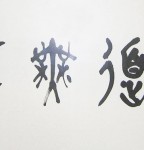The word "calligraphy" is originally a Greek word meaning "beautiful writing". In China, calligraphy, one of the traditional four arts dating back to the earliest days of Chinese history, is admired and displayed in museums just as paintings are.
For the Chinese, the ancient art of the written word is not just a method of communication but also a means of expressing the dynamic forces of the natural world. By controlling the concentration of ink, the thickness and absorption of the paper, and the flexibility of the brush, the artist is free to produce an infinite variety of styles and forms. Chinese calligraphy serves the purpose of conveying thought but also shows the "abstract" beauty of the line. Rhythm, line, and structure are more perfectly embodied in calligraphy than in painting or sculpture.
Calligraphy is an expressive art. According to an old Chinese saying, "the way characters are written is a portrait of the person who writes them", one can "read" the identity of the person through his or her handwriting. Expressing the abstract beauty of lines and rhythms, calligraphy is a reflection of a person's emotions, moral integrity, character, educational level, and accomplishments in self-cultivation, intellectual tastes and approach to life. Chinese characters, which convey ideas, are regarded as the most abstract and sublime art form.
Calligraphy is also a practical fine art. Calligraphic inscriptions written on paper, wooden plaques or stone tablets serve as decorations of a deep artistic value. Moreover, calligraphy is often used to decorate articles of everyday use. Even on the ordinary, everyday level of life, beautiful writing is appreciated. Great attention is also paid today to its development by holding exhibitions of ancient and contemporary works and by organizing competitions among youngsters and people from various walks of life.
Calligraphy manifests the basic characteristics of all Chinese arts. Closely associated with paintings - the two leaders of Chinese art forms - calligraphy takes precedence over painting since it greatly inspired the art of painting. Moreover, calligraphy has influenced other typically Chinese art forms like classical poetry, seal carving, sculpture, traditional music and dance, architecture and handicrafts.
To become an artist or expert in calligraphy, one has to practice word-by-word and stroke-by-stroke until the spirit of the practice gets into one's mind. Calligraphy can temper a person into a state in which one can apply sub-consciousness absorbed from daily practice to control the concentration of ink and the compatibility of font and size of each piece or word. To the artist, calligraphy is a mental exercise that coordinates the mind and the body to choose the best styling in expressing the content of the passage. It is a most relaxing yet highly disciplined exercise indeed for one's physical and spiritual well being. Historically, many calligraphy artists were well known for their longevity.
Chinese calligraphy, like the script itself, began with the hieroglyphs and, over the long ages of evolution, has developed various styles and schools, constituting an important part of the heritage of national culture. Chinese scripts are generally divided into five categories: the seal character (zhuan), the official or clerical script (li), the regular script (kai), the running hand (xing) and the cursive hand (cao).
Calligraphy was established as a "high art" form well before the Tang dynasty. It has continuously enjoyed a high status among the arts ever since, and is practiced today by many people, including every school-aged child. During the imperial era, calligraphy was used as an important criterion for selection of executives to the Imperial court. Unlike other visual art techniques, all calligraphy strokes are permanent and incorrigible, demanding careful planning and confident execution. Such are the skills required for an administrator/executive. While one has to conform to the defined structure of words, the expression can be extremely creative. There are seven standard strokes in the writing of Chinese characters. Some calligraphers believe there are up to thirty-two strokes.
Like chopsticks, calligraphy was once entirely Chinese, but as Chinese culture spread to Korea, Japan, and Singapore, calligraphy became a unique feature of the Oriental art. There is a general standardization of the various styles of calligraphy in the East Asian tradition. Calligraphy has also led to the development of many other forms of art in East Asia, including seal carving, ornate paperweights, and ink stones.
Widely accepted by the West, many calligraphic elements are being adopted by modern Western art. In the West, Picasso and Matisse are two artists who openly declared the influence by Chinese calligraphy on their works. Picasso even said, "Had I been born Chinese, I would have been a calligrapher, not a painter."
| < Prev | Next > |
|---|
- 2011-05-11 - 2011 6th Affordable Art Beijing Festival
- 2011-05-10 - Calligraphy in China Japan and Korea
- 2011-05-06 - The New York Times: Where the East Parts From the West
- 2011-05-01 - 2011 UN celebrates Chinese Language Day with Chinese Calligraphy exhibitions in New York
- 2011-04-09 - Anniversary of Seal Script Character “水” in Zhongtiao Mountain by Chinese Calligrapher Ding Shimei
- 2010-11-06 - 羲之真迹难觅,诸皇尊王,高古摹本亦珍, 一字千金
- 2010-07-29 - 山西陶寺扁壶毛笔朱书,将中国文字史向前推进800年
- 2010-07-24 - 天人书法网改版升级了,欢迎大家访问!
- 2010-07-21 - Calligraphy scroll smashes auction record for Chinese work of art
- 2010-06-26 - Chinese modern artist Wu Guanzhong dies












